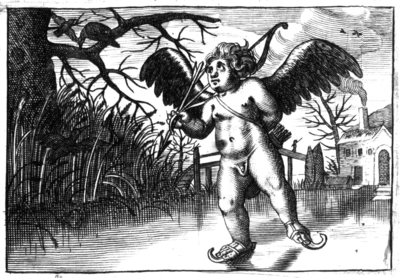In lubrico. [20]

20.
In lubrico.
Cupido leert het spel dat Hollandt heeft gevonden,
Hy proeft te gaen op 't ys, hy heeft twee schaetsen aen.
Hy heeft twee ysers scherp aen zijne voet gebonden,
Daer mede dat hy meynt op 't water vast te staen.
Het ys van selfs is glat, de ysers glat daer tegen,
Men valt seer lichtelick daer op, of oock daer in.
Het vryen gaet alsoo. die niet en is te degen
Geslepen op het werck, die duyselt in de min.
Cupido leert het spel dat Hollandt heeft gevonden,
Hy proeft te gaen op 't ys, hy heeft twee schaetsen aen.
Hy heeft twee ysers scherp aen zijne voet gebonden,
Daer mede dat hy meynt op 't water vast te staen.
Het ys van selfs is glat, de ysers glat daer tegen,
Men valt seer lichtelick daer op, of oock daer in.
Het vryen gaet alsoo. die niet en is te degen
Geslepen op het werck, die duyselt in de min.

Facsimile Images
Translations
 |
On slippery ice. |
Literature
-
More on the origins of the idea of the 'uncivilized Dutch' in: Wesseling, Are the Dutch Uncivilized?

-
On the use of typical Dutch elements in the picturae in Cats's Sinne- en
minnebeelden: Luijten, Gezien of gelezen?

Sources and parallels
-
Typical Dutch elements also used by Heinsius in: Ni spirat, immota [9] (in: Daniël Heinsius, Quaeris quid sit Amor (c. 1601))
[Compare
![Compare [compare]](/static/images/compare2.gif) ]
]
-
Same metaphor ('love is like scating on slippery ice') later used in:
Hall, Emblems with Elegant Figures
 , embl. 16
, embl. 16
-
Typical Dutch elements also used by Heinsius in: Ni spirat immota [9] (in: Daniël Heinsius, Emblemata amatoria (1607/8))
[Compare
![Compare [compare]](/static/images/compare2.gif) ]
]
-
Typical Dutch elements also used by Cats in: Dominae, quo me vocat, aura. [29] (in: Jacob Cats, Sinne- en minnebeelden (1627))
[Compare
![Compare [compare]](/static/images/compare2.gif) ]
]
-
Motto and subscriptio repeated in, although pictura clearly based on different source: De weg der liefde is glibberig [18] (in: Willem den Elger, Zinne-beelden der liefde (1703))
[Compare
![Compare [compare]](/static/images/compare2.gif) ]
]
-
Another use of typical Dutch elements within this book: Ni spirat immota. [33] (in: Daniël Heinsius, Ambacht van Cupido, from: Nederduytsche poemata (1616))
[Compare
![Compare [compare]](/static/images/compare2.gif) ]
]
-
Typical Dutch elements also used by Cats in: Dominae, quo me vocat, aura. [28] (in: Jacob Cats, Proteus (1618))
[Compare
![Compare [compare]](/static/images/compare2.gif) ]
]
References, across this site, to this page:
- Dominae, quo me vocat, aura. [28] (in: Jacob Cats, Proteus (1618))
- Dominae, quo me vocat, aura. [29] (in: Jacob Cats, Sinne- en minnebeelden (1627))
- De weg der liefde is glibberig [18] (in: Willem den Elger, Zinne-beelden der liefde (1703))
- Ni spirat, immota [9] (in: Daniël Heinsius, Quaeris quid sit Amor (c. 1601))
- Ni spirat immota [9] (in: Daniël Heinsius, Emblemata amatoria (1607/8))
- In lubrico. [20] (in: Daniël Heinsius, Ambacht van Cupido (1613))
- Ni spirat immota. [33] (in: Daniël Heinsius, Ambacht van Cupido, from: Nederduytsche poemata (1616))
Iconclass
Cupid skating in a polder- birds
[25F3]

- trees
[25G3]

- farm or solitary house in landscape
[25I3]

- landscape with bridge, viaduct or aqueduct
[25I6]

- arm stretched forward (+ holding something)
[31A2512(+933)]

- arm bent behind the back
[31A25171]

- falling (+ variant)
[31A2731(+0)]

- looking upwards
[31B6211]

- skates (winter sports)
[43C244]

- archer's weapons: bow and arrow
[45C15(BOW AND ARROW)]

- Preparedness (+ emblematical representation of concept)
[54A32(+4)]

- (personifications and symbolic representations of) Love; 'Amore (secondo Seneca)' (Ripa) (+ emblematical representation of
concept)
[56F2(+4)]

- proverbs, sayings, etc. (with TEXT)
[86(IN LUBRICO)]

- (story of) Cupid, Amor (Eros)
[92D1]

- attributes of Cupid (with NAME)
[92D18(BOW)]

- attributes of Cupid (with NAME)
[92D18(QUIVER)]

Comments
Heinsius in this emblem claims that Cupid, during his stay in Holland, learned more
than just the Dutch language. In passing, the god of love also mastered the skill of
ice-skating. The Netherlanders - inventors of the "skating game" - taught him how to
skate on their frozen canals. In the pictura we see a Dutch winter landscape and the
typical wooden skates of the Low Countries. In gaining mastery over the slippery ice,
this emblem suggests, Cupid also learned the fine points of the art of love.
The situation in love is no different from that on the ice. Like skating, the game of
love seems deceptively simple, but can only be learned by trial and error - by
falling, getting up and trying again. Now that Cupid has learned from the Dutch experts
how to stay on his feet on the ice, he can be considered truly accomplished in the art
of love.
Heinsius may have employed this positive image of the energetic, skilled Dutchman to
counter the idea current elsewhere in Europe that in the cold, wet climate of the
Netherlands only people of a crude, unrefined sort could thrive. The point here
would then be that only in the Netherlands did Cupid truly learn the fine art of loving.
The example Heinsius had set in 1601 with Quaeris sit amor?, and in 1613
with Ambacht van Cupido was followed on a large scale, both at home and
abroad. Love emblematics came to full flourish within just a few years. This specific emblem
was imitated by John Hall, in his Emblems with Elegant Figures (1658), and
was then stripped of typical Dutch characteristics and changed into a religious message to the
reader. A change which was perhaps preluded by the motto of Heinsius' emblem
that possibly contains an
allusion to Psalm 71 of the Vulgate, which declares that "the rich" find themselves
in "slippery places" and in imminent danger of destruction.
![[H O M E : Emblem Project Utrecht]](/static/images/rd-small.gif)






















































